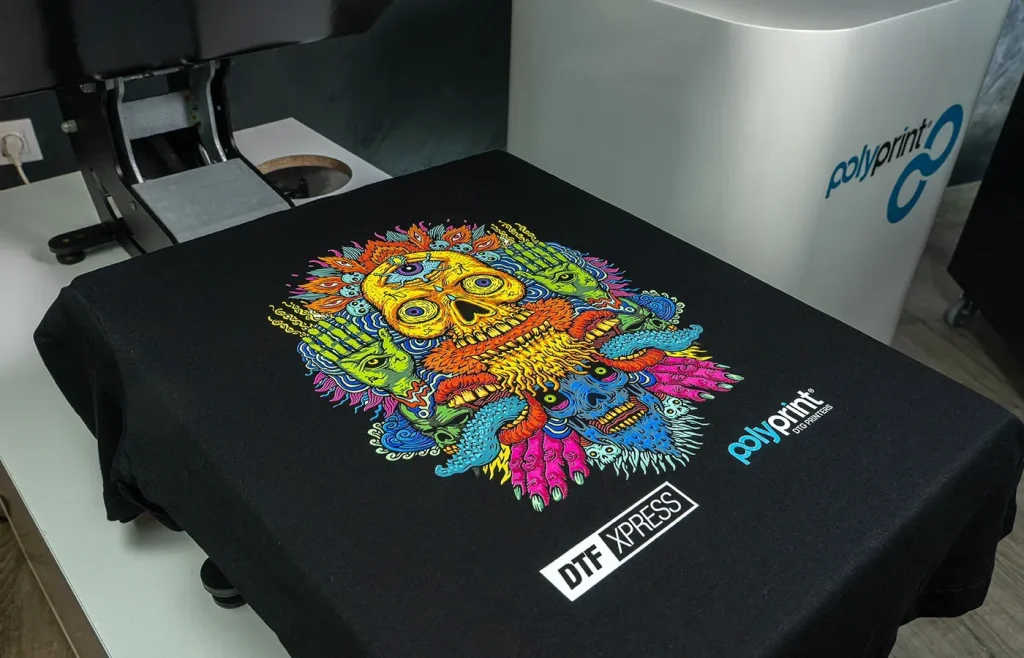DTF printing, or Direct to Film printing, has emerged as a game-changing technology in the world of fabric printing, offering vibrant colors and intricate designs that set your garments apart. This technique allows for exceptional detail and versatility on various fabric types, making it a favorite among fashion designers and printing businesses alike. Whether you’re just starting out or looking to refine your garment printing techniques, understanding the essentials of DTF printing is crucial for achieving striking results. In this guide, we’ll explore essential DTF tips and tricks that will help you maximize your printing capabilities and ensure compatibility with a wide range of fabrics. From selecting the right DTF equipment to mastering the printing process, you will be well-equipped to take your printing efforts to the next level.
Direct to Film (DTF) printing, often referred to as film-based garment printing, is transforming the landscape of textile design with its ability to create stunning, high-quality images on clothes. This cutting-edge method merges the advantages of traditional screen printing and modern digital approaches, making it a popular choice for businesses aiming to produce customizable apparel. Understanding the various DTF equipment and techniques can greatly enhance your printing quality, ensuring that designs not only look fantastic but also stand the test of time. As you delve into the world of this innovative printing process, consider different fabric compatibility, which is essential for achieving the best results in your creations. By employing effective DTF tips and tricks, you can unlock the full potential of this remarkable technology, propelling your projects and business forward.
Understanding the Basics of DTF Printing
Direct to Film (DTF) printing is an innovative method that combines the capabilities of traditional screen printing and direct-to-garment techniques to deliver vibrant, high-quality prints on various fabrics. In DTF printing, designs are printed onto a special film which is then transferred onto textiles using heat and pressure. This process not only allows for intricate designs but also provides exceptional color vibrancy, making it popular among apparel designers and retailers. The adoption of DTF printing has been boosted by its ability to handle a variety of fabric types, including cotton, polyester blends, and other synthetics, offering unprecedented versatility for garment printing.
While DTF printing brings many advantages, mastering its intricacies is crucial for achieving successful outcomes. A deep understanding of the materials and equipment involved in DTF printing—including transfer films, DTF printers, and the curing process—is essential. Equally important is learning how to optimize printing settings for various fabrics to ensure that each print meets quality expectations. By focusing on these foundational elements, businesses can harness the full potential of DTF technology and create standout products that resonate with customers.
Essential DTF Equipment for Quality Printing
When embarking on a DTF printing journey, selecting the right equipment is fundamental to achieving quality results. The cornerstone of DTF production is a reliable DTF printer, known for its high resolution and compatibility with specialized inks. Undoubtedly, leading models from reputable brands like Epson are favored for their ability to produce stunning prints at high DPI settings. In addition to the printer, a robust heat press machine is crucial for ensuring that designs are properly transferred to fabric. It should have adjustable pressure and temperature settings, allowing for flexibility based on the fabric type—an important factor in successful DTF printing.
Another vital piece of equipment in the DTF setup is the hot melt powder, which helps create a strong bond between the film and the fabric during the transfer process. Using high-quality transfer films specially formulated for DTF can enhance the adhesion and durability of prints. Moreover, regularly maintaining these pieces of equipment ensures optimal performance and longevity, which is particularly important for businesses looking to scale their printing operations. By investing in quality DTF equipment, print providers can set themselves up for success and deliver outstanding products.
Tips and Tricks for Successful DTF Printing
To excel in DTF printing, it is vital to adopt effective tips and tricks that can enhance the quality of your prints. One key tip is to optimize printer settings based on the complexity of the design and the fabric being used. Adjusting the ink density and ensuring that the printer operates at a high resolution can significantly improve print quality and vibrancy. Additionally, regular cleaning of the print heads and ensuring that ink cartridges are topped up will help avoid issues such as clogging, which can lead to diminished print quality over time.
Another valuable trick during the transfer process is to carefully monitor the application of the hot melt powder. Applying an even layer before curing is essential for achieving a successful bond between the design and the fabric. Follow the recommended curing timings and temperatures to cater to different fabric types, ensuring that the final product is both durable and visually appealing. By implementing these practical tips, DTF printers can greatly enhance the quality and longevity of their printed garments, resulting in higher customer satisfaction.
Ensuring Fabric Compatibility in DTF Printing
Understanding fabric compatibility is essential for every DTF printer aiming for successful outcomes. DTF printing is particularly effective on natural fibers like cotton and synthetic blends, which provide ideal surfaces for vibrant and lasting prints. However, experimenting with various fabrics helps to identify which combinations yield the best results. For instance, while cotton offers excellent adhesion and color brightness, polyester blends can contribute to vibrant finishes and durability, making them favorites among various garment printers.
To optimize print quality across different fabric types, conducting sample tests is invaluable. Printing on varied materials allows manufacturers to assess how well inks adhere and to determine the vibrancy of colors on each surface. By gaining insights from these tests, printers can refine their processes and make informed decisions regarding which fabrics to use in their offerings. Maintaining a focus on fabric compatibility ensures that print quality is consistent and meets customers’ expectations.
Post-Purchase Care for DTF Printed Garments
After investing in DTF printed garments, educating customers about proper care instructions is paramount to prolonging the lifespan of the prints. Advise customers to wash garments inside out using mild detergents, which helps protect the print from direct agitation during washing. It’s also crucial to recommend air drying over using a dryer, as excessive heat can compromise the integrity of the print, causing it to peel or fade prematurely.
By providing clear care guidelines, garment printers can enhance customer satisfaction and build a reputation for quality. Encouraging customers to handle their DTF printed items with care not only extends the life of the prints but also reinforces their value in the marketplace. This proactive approach establishes trust between businesses and their clients, ultimately fostering loyalty and repeated sales.
Innovating in DTF Printing: Embracing Creativity
One of the most exciting aspects of DTF printing is the endless potential for creativity and innovation. Brands that thrive are often those willing to experiment with unique colors, intricate designs, and unconventional fabric combinations. Engaging with the DTF printing community through forums, social media, and industry events can provide inspiration and ideas that spark creativity. By staying up-to-date with the latest trends and technologies in garment printing, businesses can differentiate themselves in a competitive market.
Innovative DTF printers often push the boundaries of what’s possible, leading to customized offerings that capture consumer interest. Whether it’s experimenting with glow-in-the-dark inks, incorporating multicolor gradients, or using specialty materials, the potential for new designs is limitless. Embracing this spirit of experimentation not only elevates the print offerings but also enhances the overall brand identity, making it memorable in the eyes of customers.
Frequently Asked Questions
What is DTF printing and how does it work?
DTF printing, or Direct to Film printing, is a method that involves printing designs on transfer films that are then heat pressed onto fabrics. The process merges benefits from both Direct to Garment (DTG) and traditional screen printing, allowing for vibrant colors and intricate designs on various fabrics including cotton and blends.
What equipment do I need for successful DTF printing?
Essential DTF equipment includes a reliable DTF printer compatible with specific DTF inks, a heat press machine with adjustable settings, and high-quality transfer films designed for the DTF process. Investing in good equipment is vital for achieving high-quality prints.
What are some important DTF tips and tricks for beginners?
To succeed in DTF printing, start by ensuring the right printer settings, like high resolution (1440 DPI) and proper ink density. Also, invest in quality inks and transfer films, and practice the transfer process diligently to ensure durability and vibrancy in your prints.
How do I ensure fabric compatibility for DTF printing?
DTF printing works best on fabrics like cotton and polyester blends. It’s wise to test print samples on different fabric types to determine optimal print quality and ink adhesion, as performance can vary across materials.
What should I consider when choosing DTF inks?
When selecting DTF inks, opt for specially formulated inks designed for use with transfer films. Quality inks ensure proper adhesion, vibrant colors, and durability, which are crucial for successful DTF printing results.
What post-print care instructions should I provide for DTF printed garments?
To maintain print quality, advise customers to wash DTF printed garments inside out using mild detergents, and recommend air drying instead of tumble drying to prevent heat damage. Proper care ensures longevity and satisfaction with the product.
| Key Element | Details |
|---|---|
| DTF Printing Overview | Method for transferring designs onto fabrics using transfer films and heat. |
| Equipment Required | 1. DTF Printer (e.g., Epson) for high-resolution prints. 2. Heat Press Machine for transferring designs. |
| Transfer Films | High-quality DTF transfer films for better adhesion and vibrant colors. |
| Inks | Specially formulated DTF inks for optimal adherence to films and fabrics. |
| Printing Settings | High resolution (1440 DPI) and appropriate ink density settings. |
| Transfer Process Steps | 1. Apply hot melt powder post-printing. 2. Cure with heat press (160-180°C for 15-20 seconds). |
| Fabric Compatibility | Best results on cotton and polyester blends; testing is suggested. |
| Post-Purchase Care | Recommendations for washing and drying to extend print life. |
| Creativity and Innovation | Encourage experimentation with designs and colors to stand out. |
Summary
DTF Printing is an innovative method that allows for high-quality, vibrant designs on various fabrics. By understanding the necessary equipment and techniques, anyone can embark on a successful DTF printing journey. With a focus on investing in quality printers and materials, optimizing printing settings, and mastering the transfer process, your printed garments can achieve stunning results. It is also vital to ensure proper care for the printed items, allowing them to maintain their quality and vibrancy over time. Experimentation is key in DTF printing, which not only promotes creativity but helps your business stand out in a competitive market. Emphasizing education about DTF printing will greatly contribute to your success in this growing industry.



